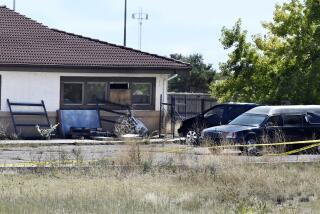Grieving Families Await Final Words of Miners
SAGO, W.Va. — The families of the men killed in this week’s mine disaster poured out their grief to political leaders Thursday as the state medical examiner’s office said it had found several farewell notes written by the men.
The notes, one scrawled on a bit of scrap paper and another on an insurance form -- which were written after 12 workers were trapped by the blast -- told loved ones that the men hadn’t suffered.
Monday morning’s blast apparently killed one Sago Mine worker immediately; the others, unable to escape, fled farther into the mine. As the hours passed and their oxygen supply dwindled, some left notes to say they were not in pain and were simply going to sleep, said Peggy Cohen, whose father, 59-year-old Fred Ware Jr., was among the 11 trapped men who died. The sole survivor remained in critical condition Thursday.
Officials with the state medical examiner’s office “told me about the notes when I went to identify my father’s body,” Cohen said. “We’re still waiting to get all of his things back, to see if there’s one for us.”
Martin Toler Jr., a 51-year-old foreman, wrote a message on the back of an insurance form: “Tell all I see them on the other side.... It wasn’t bad. I just went to sleep. I love you,” read a copy of the letter obtained by Associated Press.
Tom Toler, Martin’s older brother, told Associated Press the note was found in his brother’s pocket. “I took it to mean that it was written in the final stages,” he said.
Word of the goodbyes came as doctors warned that survivor Randal McCloy Jr. might have suffered brain damage and other serious harm to vital organs while underground for 41 hours.
McCloy was transferred from West Virginia University’s Ruby Memorial Hospital in Morgantown to Allegheny General Hospital in Pittsburgh to receive hyperbaric oxygen treatment, which delivers oxygen to organs and helps boost the body’s ability to heal.
“He is not waking up as quickly as we had hoped,” the dean of the university’s medical school, Dr. John E. Prescott, said at a news conference. “We are doing all we can for him.”
The bodies of the victims were taken to the state medical examiner’s office in Charleston to undergo autopsies, which are expected to be completed today.
“In some cases, the notes were found during the autopsy,” said John Law, a spokesman for Dr. James A. Kaplan, West Virginia’s chief medical examiner. “Some of the notes have been sent to the funeral home with the person’s clothes. Some are still here.”
Law declined to say how many notes were found or what they said.
Sen. John D. Rockefeller IV (D-W.Va.) visited the homes of several victims’ families. They sought answers about the investigation, where to find financial help and why they first had been informed that the miners survived.
Rockefeller said they told him how the miners “went to the far, far end of the mine, the very last place they could go, to get away and try to survive.”
The families “are all angry and not sure what is going to come,” he said.
Several funeral homes were meeting with religious leaders to figure out when to schedule services. One funeral was tentatively planned for Tuesday.
At Anita’s Flower Shop in Buckhannon, W.Va., owner Connie Bailey was curling black ribbon into memorial armbands and other somber decorations.
“I don’t even know how many flowers to order yet, because there are going to be so many services and funerals,” she said. “It makes me cry every time the phone rings.”
Denver Anderson, 61, said he dreaded the coming days.
A miner for about 15 years, he regularly commuted to work at the Sago Mine with his friend Jerry Groves, 56. The two drove to work early Monday, swapping stories about holiday celebrations. When they arrived, they changed into their work clothes, grabbed their hardhats and head lamps, and headed to the mine entrance.
Groves went with the first crew into the mine.
Anderson followed minutes later.
“When the explosion happened, there was only heat and rock and darkness,” said Anderson of Hacker Valley, W.Va. “We walked and crawled and ran out. All I could think about was Jerry. Now, I don’t want to think about the funeral, because that means he’s really gone.”
U.S. and West Virginia officials have launched a joint investigation into the Sago disaster, the cause of which remains unknown.
The investigation is expected to include officials from the U.S. Labor Department’s Mine Safety and Health Administration; West Virginia’s Office of Miners’ Health, Safety and Training; and representatives of International Coal Group Inc., the mine’s owner.
Although Sago was not a union mine, investigators will probably include a representative of the firm’s workers, said Terry Farley, an administrator with the West Virginia mine agency who will be on the state’s team.
A preliminary report could come within several months, but a final review might take as long as half a year to complete, Farley said.
Kenneth P. Katen, a federal mine safety official during the Reagan administration, said the groups would work together in the Sago investigation but release separate reports.
Sago’s history of federal health and safety violations, which nearly tripled from 2004 to 2005, would immediately draw scrutiny, said J. Davitt McAteer, who was assistant Labor secretary for mine safety during the Clinton administration.
“The number of violations was increasing, not decreasing” at Sago, McAteer said. “The severity and importance of the violations were increasing. We’re talking about issues such as roof control, ventilation, accumulation of combustible material.”
Two areas that particularly troubled federal inspectors last year were the mine’s ventilation plans and its placement of methane monitors. Katen and other mine safety experts say reports that the mine explosion originated in an unused section of shaft raise concerns that explosive methane gas might have built up.
The risk of methane-fueled explosions has been cited before as a serious concern in abandoned mineshaft sections, Katen noted.
Mining companies typically send inspectors to take methane readings from cinderblock seals that block off unused mine chambers.
But such measurements, while useful for checking methane near the seals, do not reliably give a complete picture of what’s happening behind the seals, Katen said. Methane levels can build farther inside the chambers. When barometric pressures rise, the gas can become volatile.
“All you would need is an igniter,” Katen said. “We’ve had situations where a simple falling stone causes a methane explosion.”
More to Read
Sign up for Essential California
The most important California stories and recommendations in your inbox every morning.
You may occasionally receive promotional content from the Los Angeles Times.










